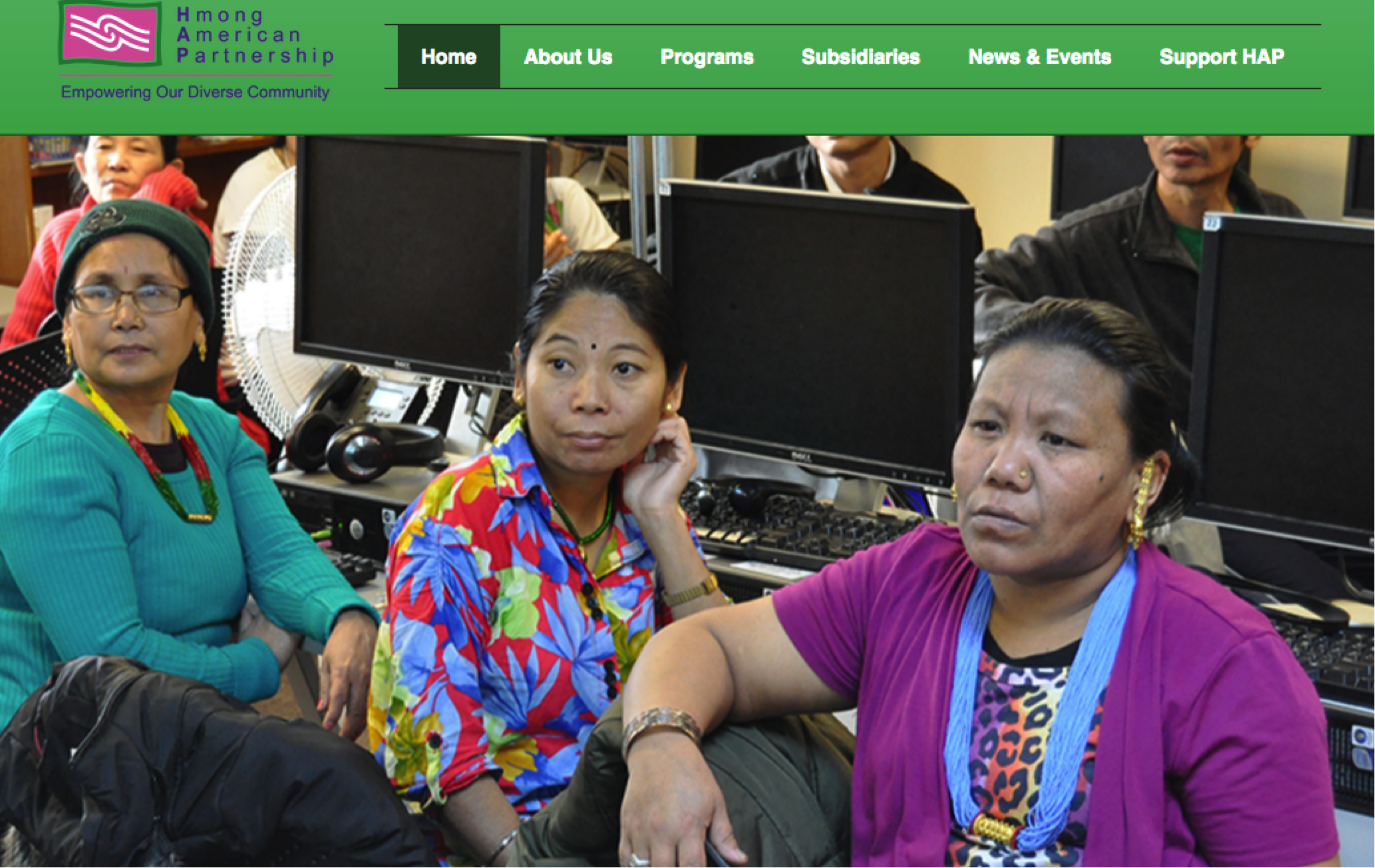In 2012, Hmong American Partnership began an ambitious, multiyear effort to improve its English as a Second Language Program. This article describes the strategic decisions and results of this effort.
On a fall day in 2013, the intersection of Western and University Avenues in Saint Paul hums and rumbles with activity. Cars and trucks stream by, minivans full of children pull into shopping centers, and hungry patrons pound the sidewalks in search of the perfect bowl of pho (noodle soup). Every ten minutes, the 16 bus glides to a stop at Western Avenue, and a crowd that reflects the diversity of the city emerges from within. Some of them are arriving home and some of them are arriving to work. Some of them are adult refugees arriving to classes at the Hmong American Partnership (HAP) English School. The students are ready for their first day at the newly reopened program. The road takes us from where we have been to where we want to go. This is the road to improvement.
Founded in 1990, the English School at HAP provides ESL, numeracy, digital literacy, and job skills classes to mostly newly-arrived refugees. The English School is just one program among many services that HAP provides to Hmong and other refugee communities. Programs include Education and Training (including Adult Basic Education), Economic and Community Development, Employment Services, Health and Wellness, and Children and Family Services. This article will center on the ESL classes for adults at the Western and University location in St. Paul.
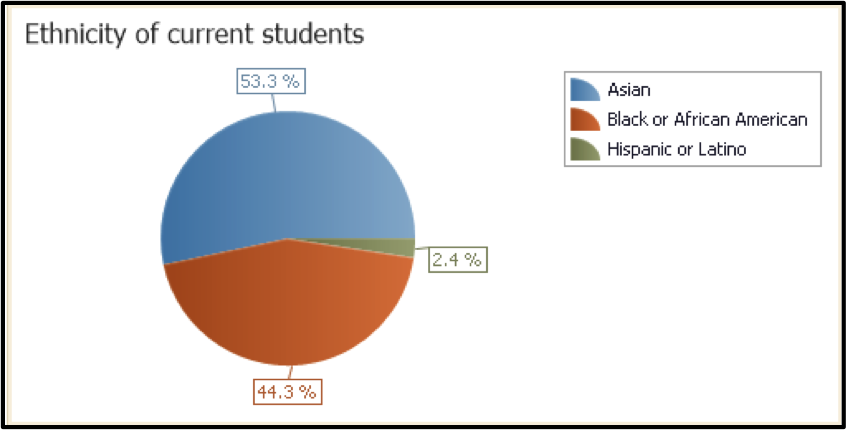
Though the English School was originally started to help Hmong students, the current enrollment of HAP English School closely reflects the diversity of the immigrant groups residing in the area. The program currently hosts one hundred twenty-five students, whose ethnicities are identified in Figure 1.
Over half of the ABE students are Asian (53.3%), and most of them are Karen, Karenni, and Bhutanese. Another large segment of students is African (44.3%), most of whom are Somali and Oromo. A small number of Latinos attend classes (2.4%). The student population is overwhelmingly refugee in background.
Fall of 2012- The Reckoning
In 2011, after several years of economic recession, changing governmental grants, and falling donations, HAP, like many nonprofits, faced many budget issues as an organization. In an attempt to save the budget, cuts were made in several areas of programming. One item that was cut was the school van, which provided transportation to dozens of ESL students every day. Staff made every effort to transition students to public transportation or schools closer to their homes according to the students’ preferences, but many students chose to leave the school and enroll elsewhere. Figure 2 shows that HAP hit a low in contact hours in 2012. This contributed to a budget deficit for the following program year.
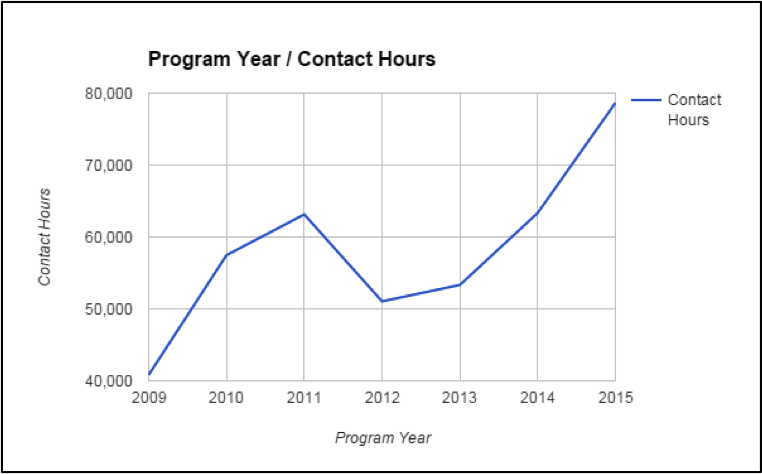
Falling contact hours and stagnant enrollment were not the only problems facing HAP English School in 2011-2012. The school had also failed to meet any National Reporting Service (NRS) target goals since 2009, when it succeeded in achieving only one goal (NRS is an outcome-based reporting system for federally funded adult education programs administered in Minnesota and other states). Every year, the state issues goals for Adult Basic Education (ABE) programs. The goals call for a certain percentage of students in each ABE level to move on to the next ABE level within one program year. For example, in 2011 the target goal for Beginning ESL Literacy was a 54% advancement rate to the next level within one program year, which HAP English School failed to achieve. Programs that fail to meet the goals for several years in a row are considered in need of improvement. This forced the education team to take a look at how to address the needs of the program, and specifically its students, in order to improve.
The staff identified a number of issues which prevented the school from being fully successful. These issues were: difficult scheduling, high staff turnover, a lack of professional development opportunities, lack of cohesive curricula, lack of focus (doing too many things in a disorganized way), and a generally chaotic school environment (students dropping in and out of the program rapidly). The staff brainstormed a set of six changes to address the issues. Each will be described in more detail below.
Change #1- Scheduling
Up until 2012, the class schedule did not take into full consideration the needs of the students. The schedule also used the available space inefficiently.
Many HAP students are Minnesota Family Investment Program (MFIP) clients who are required to attend ESL classes 20 hours a week in order to receive benefits from Ramsey County and the state. With the old schedule, students attended classes in the morning from 8:00 AM to 12:00 or 1:00 PM to 5:00. During the four hour blocks, teachers broke the day up into English instruction, math instruction, and computer classes.
Most of the students in HAP English School’s program are parents of school-aged children. This creates a difficulty in getting to school at 8:00 AM when their children might need to catch a school bus in the morning or staying until 5:00 PM when their children arrive home from school much earlier than that. The schedule was inconvenient for students, and they often left for programs that were more in line with their daily schedules. Research also indicates that students make higher gains when they are able to attend a “higher percentage of class time”, not the total number of hours (Wrigley, 2003, p.3), so we wanted to remove any barriers to consistent attendance. As such, in late 2012 HAP English School created a new schedule to consolidate the day to more closely match the school day for children (the new schedule went into effect in March of 2013). The new schedule consists of two tracks that overlap in the morning and afternoon and make the most effective use of space available.
Another benefit of the new schedule is that it accommodates working students and students that are not part of the MFIP program. If students wish to enroll only in the two-hour ESL block, they can do that under the new schedule. Previously, they had been required to enroll in the entire four-hour session. Four hours of school every day is hard for a working parent, but two hours is often manageable.
The new schedule also allows the program to use the available space more efficiently. Instead of leaving rooms vacant for large chunks of the day, every room was utilized at almost every time. Additionally, the new schedule allowed the students to attend “job club” (a class for MFIP clients) on-site, rather than at a different site, as had previously been done. In October of 2013, HAP English School moved into a different office building across the street from the previous building. The implementation of the schedule in a new space was seamless.
Change #2- Staffing and Professional Development Opportunities
In addition to addressing student needs, the new schedule made the teaching positions more attractive to teachers who wanted full-time positions. Since 2010, HAP English school had had only 1 full-time teaching position. The rest of the teachers worked part- time: either 25 hours a week during the day (4 hours of instructional time and 1 hour of prep per day Monday through Friday) or 15 hours a week in the evening program (3 hours of instructional time and 1 hour of prep per day Monday through Thursday). The limited number of work hours available resulted in frequent staff turnover, with some teachers staying as little as three months before moving on to other teaching positions that offered full-time hours and benefits.
The new schedule meant that a single teacher could teach both the Track A and Track B English and math classes for their level between 9:00 AM and 3:00 PM. With the addition of 2 hours of prep time, this fit nicely into an 8-hour workday and HAP consolidated several part-time positions into 3 full-time positions with benefits. Initially, there was still one part-time position in the evening program, but that has now been replaced by all volunteer instructors and a full-time coordinator.
Change #3- Curricula
Prior to 2013, HAP English School lacked a formal, cohesive set of curricula for the ESL classes. The topics for each class were left to the discretion of each individual instructor. In addition, high staff turnover contributed to a lack of progression from topic to topic, and the classes had a very disjointed feel. There was no formal investigation into what topics the students found valuable, and the quality of instruction varied widely from classroom to classroom.
To build a more cohesive curriculum centered on student needs and interests, we knew that we needed to hear from the students. During the 2013-2014 program year, students met with interpreters every six weeks to give feedback about the previous unit, and staff used that information to make changes and additions and the staff decided that the school curriculum would follow eight thematic units over the course of the calendar year, each lasting six weeks. The units are as follows: Community, Health, Housing, School and Family, Shopping, Work, Food, and Transportation, with corresponding numeracy units. Every class level follows the same progression through the units; this allows for joining together in field trips and speakers. The digital literacy and job club courses also take inspiration from the current thematic unit, tying all of the programming together and binding all of the students together on the same topic. This decision was made to streamline the student experience at the school, so as to reduce confusion and build community amongst the students and staff. It also provided the ability to combine classes in the event of an unexpected absence of a staff member. Consequently, at any time, the students study the same topic, but at different levels.
The staff was able to develop the streamlined curricula because of an intentional investment on the part of Hmong American Partnership to give staff more time for planning. Staff was given two planning days after each six-week unit. Staff members used this time to meet, collaborate, research, and write new curricula.
Change #4- Creating a Focus on Recent-Arrival Students with Interrupted Formal Education
Until the transition in March 2013, HAP English school had either two or three classes in the morning and two or three in the afternoon, which were constantly re-leveled depending on the number of students enrolled at a given time. This created a sense of chaos among students and staff. Often, these classes were broken into mixed CASAS levels 0-1 – Pre-Beginning and Low Beginning ELL, 2-3 – High Beginning and Low Intermediate ELL, and 4-5 – High Intermediate and Advanced ELL (CASAS is the Comprehensive Adult Student Assessment System, a competency-based assessment that tests life skills). Occasionally, classes were broken into level 0, level 1-2, and level 3+. Students in levels 4 and 5 were at high enough levels that they consistently left the program so quickly it was difficult to keep a paid instructor to teach the class.
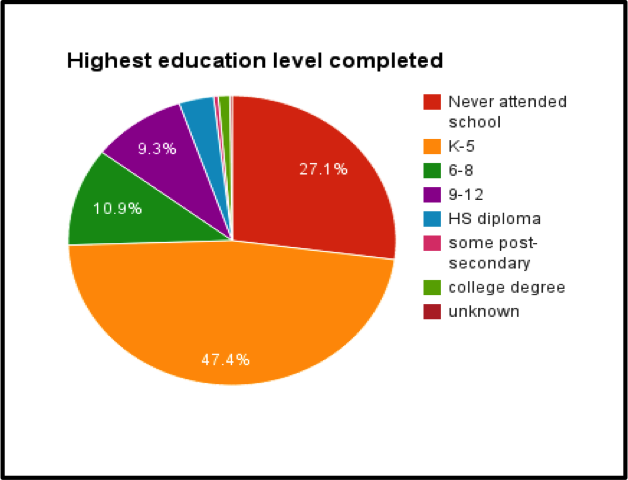
More than a quarter of HAP’s students have never attended school, and almost half have less than a 5th grade education (Figure 3). Recognizing that 75% of our students had limited or interrupted formal education and fell between CASAS levels 0 and 4, staff decided to focus on these levels and keep class leveling consistent as level 0, 1-2, and 3-4. Level 0 (or pre-literate students) seemed to do best when in their own designated class, so this was made a priority. Instruction was also tailored to focus on methods that catered to the needs of students at these levels such as those referenced in Condelli and Wrigley’s What Works Study, “bringing the outside in, varied practice and interaction strategy, emphasis on oral communication” (2006, p. 127). Students who reach level 5 are referred to another program that offers more for students at more advanced levels.
Change #5 Semi-managed enrollment
During this time, HAP English School also moved towards a more intentional system of enrollment, called semi-managed enrollment. Prior to 2013, students were allowed to join classes whenever they wanted to (something that continues to happen in many ABE programs throughout the state). With semi-managed enrollment, the program lets students begin on Mondays only, with a restriction placed on the sixth week of each unit, during which no new students can enter the class (the sixth week of the unit is when staff conduct assessments). In the curriculum redesign, the staff created a plan situating the start of new lessons on Monday, so the instructors introduce new material to all of the students, both new and returning. Semi-managed enrollment reduced the chaos and stress for teachers and students associated with new students coming into the classrooms on random days.
Change #6- Bringing Back Limited Transportation
Staff identified the 2011 elimination of transportation as having a detrimental effect on student attendance and hours. The ESL staff successfully advocated for HAP to bring back the school van on a limited basis. Prior to the 2011 decision, the van had been available to all students, no matter where they lived, creating a chaotic van route that often picked up students who lived within walking distance of the school. During the reimplementation of the van, a radius around the school was designated as “walkable” and students within this radius would not be offered transportation. Next, transportation was consolidated into “hubs” or “stops” as much as possible so that several students could be picked up from a single location as opposed to individual home pick-ups. Finally, students who had previously left the school and were not currently enrolled elsewhere were given the choice to re-enroll and use the van to transport them again, if there was space available on the van. These various efforts have succeeded in transitioning the school from being dependent on transportation to having a mix of students who ride the van and transport themselves. Less than ⅓ of students now use the school’s transportation. Attendance is now taken on the van to gauge how consistently students are actually riding it. Those not using the van and/or attending classes fewer than 3 days a week are asked to give their spot to new enrollees who are on a waiting list.
Results- Two Years In
Two years in, HAP English School has had some promising results. First and foremost, enrollment has increased dramatically and the number of students has begun to remain consistent throughout the year. Prior to the programmatic changes, the school experienced a drastic drop in enrollment every year during the summer months (as shown in Figure 4).
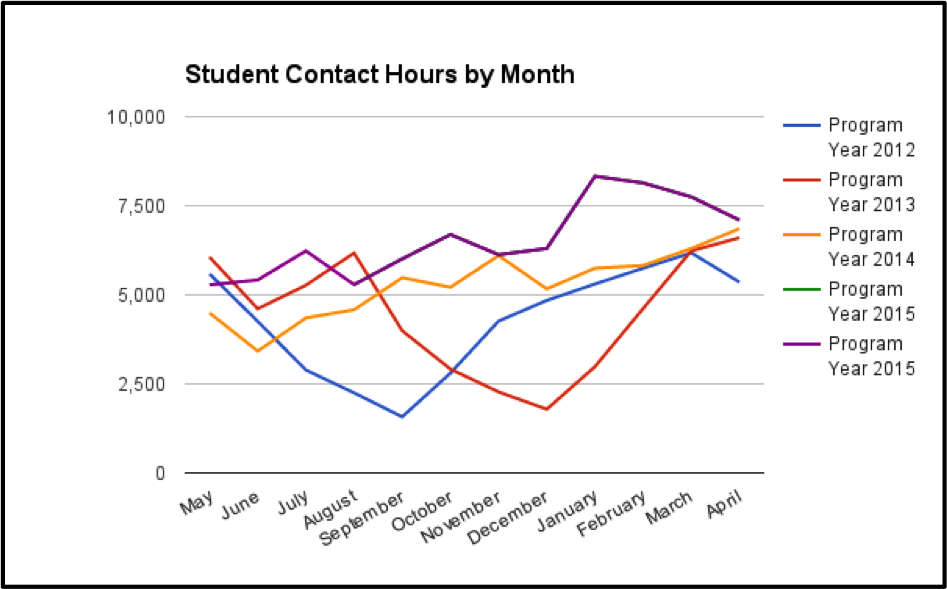
The consistent numbers throughout the year have led to implementation of wait lists during the winter months in order to keep class sizes at a reasonable number due to space and the desire to keep classes small for lower level students. Contact hours have increased drastically from 53,348 in 2013 to 63,335 in 2014 and 78,663 in 2015 (for earlier years refer to Figure 1).
Student level gains were such that HAP met four of six NRS (National Reporting Service) goals in 2014, as opposed to zero in 2013. However, in late 2014 the federal government put new rules in place requiring students to attend classes for 40 hours before being post-tested, which may have led to the drop in percentage in that program year. This increased the number of students who left before being post-tested, and consequently, the program met only one of six goals in 2015. As HAP English School begins to adapt to the new federal guidelines, the program will see how this affects its ability to meet the NRS goals in the long term.
The staff turnover has improved as well. Only one teacher, a part-time staff member, left during this two-year period, and one of the full-time ESL teachers transitioned into that position. Offering more full-time positions with benefits led to greater staff satisfaction and lowered staff turnover. This is turn led to more stability among the ESL classes and perhaps greater levels of student retention.
Next Steps
Now that HAP has achieved some stability the staff has identified two next-step goals. One goal is to incorporate more Trauma-Informed Care policies into our practices. Because the vast majority of our student population share a refugee background, many of our students have a history of trauma. They have seen brutal acts of war and their homes and villages destroyed. Although they are trying to build new lives for themselves in Minnesota, they often bring their trauma into the classroom with them. We want to implement practices that help the students relax, stay calm, and stay focused on the task at hand – learning.
The other goal will be to align our curricula to the College and Career Readiness Standards (CCRS) for Adult Education. The CCRS provide a guideline for preparing adult students for success in reading, writing, and mathematics. Aligning our curricula to the CCRS will help us transition our students to the workforce as well as higher levels of education.
References
Condelli, L. & Wrigley, H. (2006). Instruction, language and literacy: What Works study for adult ESL literacy students. In van de Craats, Kurvers & Young-Scholten (Eds.), Low-Educated Second Language and Literacy Acquisition symposium proceedings (pp 111-134). LOT: The Netherlands.
Wrigley, H. (2003). A conversation with FOB…What works for adult ESL students. Focus on Basics 6(C). Retrieved November 15, 2015 from http://www.ncsall.net/index.html@id=189.html
Resources
More on Adults with Limited or Interrupted Formal Education
http://atlasabe.org/professional/adult-esl
http://www.ncsall.net/index.html@id=771&pid=189.html
http://www.leslla.org/files/resources/CompleteproceedingsLESLLA2005.pdf
More on CASAS Levels: https://www.casas.org/docs/pagecontents/eslsld.pdf?sfvrsn=4?Status=Master
More on Trauma Informed Care: http://www.traumainformedcareproject.org/
More on NRS Levels: http://www.mnabe.org/program-management/accountability-nrs

